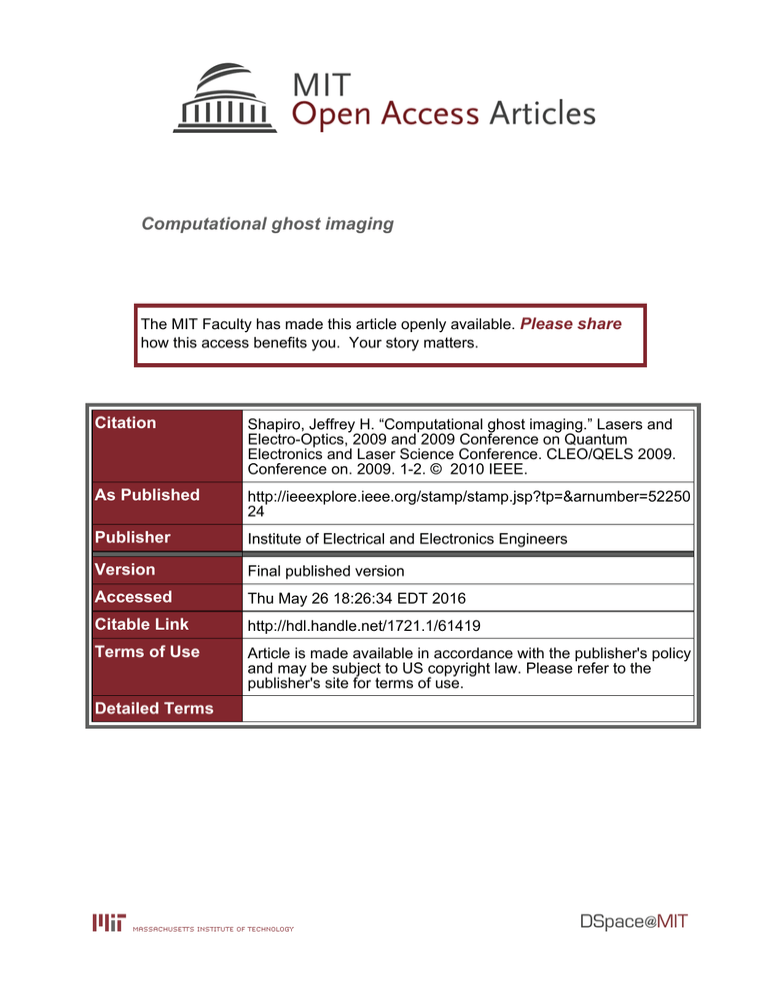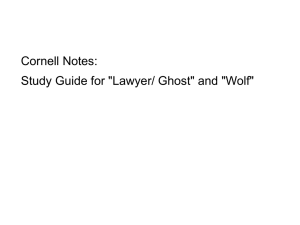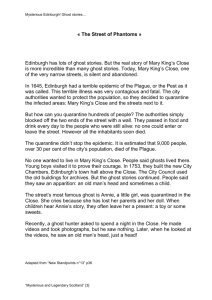Computational ghost imaging Please share
advertisement

Computational ghost imaging
The MIT Faculty has made this article openly available. Please share
how this access benefits you. Your story matters.
Citation
Shapiro, Jeffrey H. “Computational ghost imaging.” Lasers and
Electro-Optics, 2009 and 2009 Conference on Quantum
Electronics and Laser Science Conference. CLEO/QELS 2009.
Conference on. 2009. 1-2. © 2010 IEEE.
As Published
http://ieeexplore.ieee.org/stamp/stamp.jsp?tp=&arnumber=52250
24
Publisher
Institute of Electrical and Electronics Engineers
Version
Final published version
Accessed
Thu May 26 18:26:34 EDT 2016
Citable Link
http://hdl.handle.net/1721.1/61419
Terms of Use
Article is made available in accordance with the publisher's policy
and may be subject to US copyright law. Please refer to the
publisher's site for terms of use.
Detailed Terms
© 2009 OSA/CLEO/IQEC 2009
a706_1.pdf
IThK7.pdf
IThK7.pdf
Computational Ghost Imaging
Jeffrey H. Shapiro
Research Laboratory of Electronics, Massachusetts Institute of Technology, Cambridge, MA 02139, USA
jhs@mit.edu
Abstract: A computational ghost-imaging arrangement that uses only a single-pixel detector is
described. It affords a new 3D sectioning capability and matches the resolution of pseudothermal
ghost imaging.
c 2009 Optical Society of America
OCIS codes: (110.4980) Partial coherence in imaging; (270.5290) Photon statistics; (030.1640) Coherence.
Ghost imaging is the acquisition of object information by means of photocurrent correlation measurements. It has been demonstrated with biphoton light [1] and pseudothermal light [2]. Recently [3], we
established a Gaussian-state analysis of ghost imaging that unified prior work on biphoton and pseudothermal sources. Our analysis indicated that ghost-image formation is intrinsically due to classical coherence
propagation. Other recent work [4], however, has ascribed pseudothermal-light ghost imaging to nonlocal
two-photon quantum interference. We will show [5] that ghost imaging can be accomplished with only one
detector, viz., the bucket detector that collects a single pixel of light which has interacted with the object.
As only one light beam and one photodetector are required, this imaging configuration cannot depend on
nonlocal two-photon interference. Moreover, it affords a new 3D sectioning capability.
Consider the pseudothermal-light lensless ghost imaging setup shown in the left panel of Fig. 1, in which
−iω0 t
E
and ER (ρ, t)e−iω0 t are scalar, positive frequency, classical signal and reference fields with
pS (ρ, t)e
photon/s units and center frequency ω0 . They are the outputs from 50-50 beam splitting of E(ρ, t)e−jω0 t ,
a continuous-wave (cw) laser beam that has been transmitted through a rotating ground-glass diffuser. The
signal and reference undergo paraxial diffraction over L-m-long free-space paths, yielding measurement-plane
fields with baseband envelopes E1 (ρ, t) and E2 (ρ, t). The field E1 (ρ, t) illuminates a shot-noise limited pinhole
photodetector centered at ρ1 with sensitive region ρ ∈ A1 . The field E2 (ρ, t) illuminates an amplitudetransmission mask T (ρ), located immediately in front of a shot-noise limited bucket photodetector with
sensitive region ρ ∈ A2 . The photocurrents from these detectors are ac-coupled into a correlator that time
averages their product to estimate their ensemble-average cross correlation, C(ρ1 ), as the pinhole detector
is scanned over the plane. Pseudothermal light is well modeled as a narrowband classical Gaussian random
process with a coherence-separable, Gaussian-Schell model correlation structure. It follows that the ghost
image cross-correlation function in the far field of that spatially incoherent source is given by [3]:
2 2
C(ρ1 ) = q η A1
2P
πa2L
2 Z
dρ e−|ρ1 −ρ|
2
/ρL 2
|T (ρ)|2 ,
(1)
A2
for a transparency that lies within the aL -radius illuminated region. In this expression: q is the electron charge;
η is the photodetector quantum efficiency; A1 is the pinhole area; P is the photon flux of the source; and
aL = λ0 L/πρ0 and ρL = λ0 L/πa0 give the image-plane intensity radius and coherence radius, respectively,
in terms of their source-plane counterparts, a0 and ρ0 ≪ a0 , and the laser wavelength λ0 . Equation (1) shows
that the pseudothermal ghost image is erect, with spatial resolution set by ρL .
It is now possible to identify two new configurations for lensless ghost imaging. The first is shown in
the right panel of Fig. 1. We transmit a cw laser beam through an idealized spatial light modulator (SLM)
consisting of d × d pixels arranged in a (2M + 1) × (2M + 1) array with 100% fill factor within a D × D
opaque pupil, where D = (2M + 1)d and M ≫ 1. This SLM imposes a phase φnm (t) on the light transmitted
through pixel (n, m), with {eiφnm (t) : −M ≤ n, m ≤ M } being independent identically-distributed random
processes obeying heiφnm (t) i = 0 and hei[φnm (t2 )−φjk (t1 )] i = δjn δkm e−|t2 −t1 |/T0 , where the coherence time T0
is long compared to the response times of the ac-coupled photodetectors. In this source’s far field, E1 (ρ, t)
and E2 (ρ, t) will have intensity widths ∼λ0 L/d and coherence lengths ∼λ0 L/D. Furthermore, Central Limit
Theorem considerations imply that E1 (ρ, t) and E2 (ρ, t) may be taken to be jointly Gaussian. Hence our
SLM configuration will produce a ghost image of spatial resolution λ0 L/D within a spatial region of width
λ0 L/d. This ghost imager could use noise generators to drive the SLM, but it is more interesting to employ
strong sinusoidal modulation, φnm (t) = Φ cos[(Ω0 + ∆Ωnm )t], with different ∆Ωnm for each pixel.
978-1-55752-869-8/09/$25.00 ©2009 IEEE
© 2009 OSA/CLEO/IQEC 2009
a706_1.pdf
IThK7.pdf
IThK7.pdf
cw laser
cw laser
correlator
correlator
Fig. 1. Left panel: configuration for pseudothermal lensless ghost imaging. Right panel: configuration for
spatial light modulator lensless ghost imaging
The configuration for computational ghost imaging, shown in Fig. 2, uses deterministic modulation of a
cw laser beam to create the field E2 (ρ, t) that illuminates the object transparency, after which it is collected
by a bucket (single-pixel) detector. Knowing the deterministic modulation allows us to use diffraction theory
to compute the intensity pattern that would have illuminated the pinhole detector in the usual lensless ghost
imaging configuration. The time-average correlation function, between the ac-coupled photodetector output
˜ 1 , t), will then be a background-free ghost
and the mean-value subtracted computed intensity pattern, ∆I(ρ
image with spatial resolution λ0 L/D over a spatial extent of width λ0 L/d. Because only one photodetector
has been employed, this computational ghost image cannot be due to nonlocal two-photon interference.
cw laser
correlator
Fig. 2. Configuration for computational lensless ghost imaging.
Computational ghost imaging obviates the need for a high spatial-resolution detector. In addition, it
permits 3D sectioning to be performed. To see that this is so, consider the depth of focus for the pseudothermal
case , i.e., how badly its ghost image is blurred if the object is at z = L but the pinhole detector is at
z = L + ∆L. In the near-field of the pre-diffuser laser beam, it turns out that this focal region is a very small
fraction of the source-to-object path [5]. Consequently, the pseudothermal ghost imager can only image one
focal region at a time for a range-spread object viewed in reflectance. However, because the computational
ghost imager can precompute ∆I˜1 (ρ1 , t) for a wide range of propagation distances, the same bucket-detector
photocurrent can be correlated with many such ∆I˜1 (ρ1 , t) to perform 3D sectioning of the object’s reflectance.
In conclusion, we have introduced two new ghost imaging configurations: spatial light modulator and
computational ghost imaging. The latter only needs a single-pixel detector and enables 3D sectioning to be
performed.
This work was supported by the U. S. Army Research Office, the DARPA Quantum Sensors Program,
and the W. M. Keck Foundation for Extreme Quantum Information Theory.
References
1. T. B. Pittman, Y. H. Shih, D. V. Strekalov, and A. V. Sergienko, Phys. Rev. A 52, R3429 (1995).
2. A. Valencia, G. Scarcelli, M. D’Angelo, and Y. Shih, Phys. Rev. Lett. 94, 063601 (2005); F. Ferri, D. Magatti, A. Gatti,
M. Bache, E. Brambilla, and L. A. Lugiato, Phys. Rev. Lett. 94, 183602 (2005).
3. B. I. Erkmen and J. H. Shapiro, Phys. Rev. A 77, 043809 (2008).
4. R. Meyers, K. S. Deacon, and Y. Shih, Phys. Rev. A 77, 041801(R) (2008); Y. Shih, arXiv:0805.1166 [quant-ph].
5. J. H. Shapiro, arXiv:0807.2614 [quant-ph].






